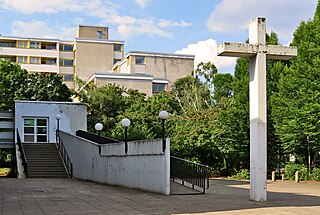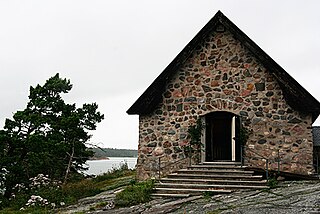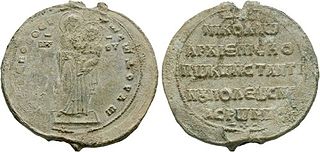
The Bulgarian Orthodox Church, legally the Patriarchate of Bulgaria, is an autocephalous Orthodox jurisdiction. It is the oldest Slavic Orthodox church, with some 6 million members in Bulgaria and between 1.5 and 2 million members in a number of European countries, the Americas, Australia, New Zealand and Asia. It was recognized as autocephalous in 1945 by the Ecumenical Patriarchate of Constantinople.
Sergius II was the Ecumenical Patriarch of Constantinople from July 1001 to 1019.
Philotheos Kokkinos was the Ecumenical Patriarch of Constantinople for two periods from November 1353 to 1354 and 1364 to 1376, and a leader of the Byzantine monastic and religious revival in the 14th century. His numerous theological, liturgical, and canonical works received wide circulation not only in Byzantium but throughout the Slavic Orthodox world.

St. Methodios I or Methodius I, was Ecumenical Patriarch of Constantinople from March 4, 843 to June 14, 847. He was born in Syracuse and died in Constantinople. His feast day is celebrated on June 14 in both the East and the West.

St. Michael's Golden-Domed Monastery is a functioning monastery in Kyiv, the capital of Ukraine. The monastery is located on the right bank of the Dnieper River on the edge of a bluff northeast of the Saint Sophia Cathedral. The site is located in the historic administrative Uppertown and overlooks the city's historical commercial and merchant quarter, the Podil neighbourhood.

The Monastery of Stoudios, more fully Monastery of Saint John the Forerunner "at Stoudios", often shortened to Stoudios, Studion, or Stoudion,, was a Greek Orthodox monastery in Constantinople, the capital of the Byzantine Empire. The residents of the monastery were referred to as Stoudites. Although the monastery has been derelict for half a millennium, the laws and customs of the Stoudion were taken as models by the monks of Mount Athos and of many other monasteries of the Orthodox world; even today they have influence.
Paul IV, known as Paul the New was Ecumenical Patriarch of Constantinople from 780 to 784. He had once opposed the veneration of icons but urged the calling of an ecumenical council to address the iconoclast controversy. Later, he resigned and retired to a monastery due to old age and illness. He was succeeded by Tarasios, who was a lay administrator at the time.

The Greek Orthodox Archdiocese of Australia is the Australian archdiocese of the Greek Orthodox Church, part of the wider communion of Orthodox Christianity. The archdiocese is a jurisdiction of the Ecumenical Patriarchate of Constantinople. As of 2015, there were over 120 parishes and eight monasteries in the four diocesan districts of the archdiocese.
Constantine III Leichoudes, was the Ecumenical Patriarch of Constantinople from 1059 to 1063.

In the history of Christianity, the first seven ecumenical councils include the following: the First Council of Nicaea in 325, the First Council of Constantinople in 381, the Council of Ephesus in 431, the Council of Chalcedon in 451, the Second Council of Constantinople in 553, the Third Council of Constantinople from 680–681 and finally, the Second Council of Nicaea in 787.

Euthymius I Syncellus was the Ecumenical Patriarch of Constantinople from 907 to 912. A monk since his youth, he became spiritual father of the future emperor Leo VI the Wise, and was raised by him to the high ecclesiastical office of syncellus. Despite his turbulent relationship with Leo, in 907 he was appointed to the patriarchate and held the post until his deposition shortly before or after Leo's death in 912.
Parthenius III was Ecumenical Patriarch of Constantinople in 1656–1657. In 1657 he was charged with treason by the Ottoman Sultan and hanged, after refusing to abjure his own Christian faith. He is hence revered as New Hieromartyr Parthenius III and his feast day in the Eastern Orthodox Church is March 24.
Sisinnius II became Ecumenical Patriarch of Constantinople in 996 and held the post until his death in 998.

The Protestant Church of Plötzensee is situated in Berlin-Charlottenburg-Nord and was inaugurated in 1970 as the second church building of the Protestant Congregation in North-Charlottenburg within the Evangelical Church of Berlin-Brandenburg-Silesian Upper Lusatia. As it is located close to the former Plötzensee Prison, the church-building was designed as a memorial for the victims of National Socialism. The paintings Plötzenseer Totentanz painted by the Viennese artist Alfred Hrdlicka are an important part of this church.
Seraphim II Anina, was the Greek Ecumenical Patriarch of Constantinople from 1757 until 1761.

Capella Ecumenica Sanctæ Annæ in scopulis is a chapel in the archipelago of S:t Anna, in the province of Östergötland in Sweden.

Nicholas II Chrysoberges, was Ecumenical Patriarch of Constantinople from 984 to 991.

The Eastern Orthodox Churches form a Christian denomination in Germany. With up to 2 million adherents, the Church is Germany's third-largest Christian denomination after Roman Catholicism and the Evangelical Church in Germany (EKD). It has grown due to immigration from Eastern Europe, especially Romania, Greece, the former Soviet Union, and the former Yugoslavia.
Monastery of St. Michael may refer to:
Joseph I Galesiotes was a Byzantine monk who served twice as Patriarch of Constantinople, from 1266 to 1275 and from 1282 until shortly before his death in 1283. He is most notable as an opponent of Emperor Michael VIII Palaiologos' plans to unite the Orthodox Church with the Catholic Church, for which he is recognized as a confessor by the Orthodox Church.










